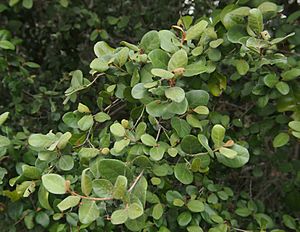Wild prune facts for kids
Quick facts for kids Wild prune |
|
|---|---|
 |
|
| Scientific classification | |
| Genus: |
Sersalisia
|
| Species: |
sericea
|
| Synonyms | |
|
Pouteria sericea |
|
Sersalisia sericea, also known as the wild prune, mangarr, or mongo, is a type of shrub or small tree. It belongs to the plant family called Sapotaceae. These plants grow naturally in northern Australia.
About the Wild Prune Tree
The wild prune is a fascinating plant found in Australia. It is known for its tasty fruit and unique appearance. This plant is an important part of the natural environment and is also used by local people.
Where Does It Grow?
Sersalisia sericea grows in several different natural areas across northern Australia. You can find it in places like monsoon forests, which are forests that get a lot of rain during certain seasons. It also grows in littoral rainforests, which are forests found near the coast. Sometimes, it can even be seen in more open forest areas.
What Does It Look Like?
This plant can grow up to 6 metres (about 20 feet) tall, which is like a small tree. However, it can start making fruit even when it's just a small shrub, only about 1 metre (3 feet) tall.
One special thing about the wild prune is its leaves and buds. They are covered in thick, rusty-brown hairs. This gives the plant a unique look. It produces small, green-white flowers that grow in clusters. After the flowers, the plant grows dark purple fruit. These fruit are juicy and usually have one or sometimes two seeds inside.
What Are Its Uses?
The fruit of the Sersalisia sericea is juicy and safe to eat. It is considered a "bush food" in Australia, meaning it's a traditional food source found in the wild.
The Kunwinjku people, who live in Western Arnhem Land, have their own name for this plant and its fruit: "mandangnud." Besides being a food source, the seeds from the fruit are sometimes used to make jewellery. These seed necklaces and other items are often sold to tourists visiting the region.

